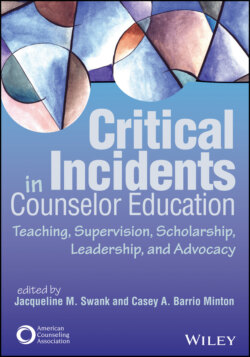Читать книгу Critical Incidents in Counselor Education - Группа авторов - Страница 60
Case Analysis and Discussion
ОглавлениеThe ACA Code of Ethics (ACA, 2014) suggest that counselor educators integrate multiculturalism into all classes (Standard F.7.c.). The Multicultural and Social Justice Counseling Competencies (MSJCC; Ratts et al., 2016) include an examination of the role intersectionality has in the development of one’s identity (C. D. Chan et al., 2018). Central to the MSJCC is the idea that one must be willing to explore one’s subjective understanding of self (Melamed et al., 2020).
Manis (2012) argued that didactic multicultural education alone may not be enough to promote the competencies necessary to understand mental health and wellness from a framework of cultural diversity and social justice. Rather, innovative teaching strategies across the curriculum should task students with critically exploring subjective understanding of their intersectionality and in turn understanding and accepting the subjective experiences of their clients (Melamed et al., 2020). It is critical that counselor educators adopt a pedagogical approach that provides instruction while infusing aspects of the MSJCC.
In the early 1990s, Ladson-Billings began to research the integration of cultural competence and pedagogy. Ladson-Billings (1995a) viewed culturally relevant teaching (CRT) as an action-oriented process that empowers students at the collective level as opposed to traditional pedagogy, which focuses on the individual level. This approach includes three main propositions (Ladson-Billings, 1995b): (a) Students are viewed as a community of learners, and thus they are responsible for one another; (b) the classroom is viewed as a communal learning environment in which success becomes the focal norm; and (c) transformative change comes by way of critical interaction and dialogue. Thus, a persistent emphasis is placed on collaboration within the classroom.
hooks (2003) stated that to promote a collaborative experience the classroom should become “a place of liberating mutuality where the teacher and student work in partnership” (p. xv). A central tenet of CRT is that the educator authentically believes that if students are treated competently they will demonstrate high levels of competency (Ladson-Billings, 1994). Thus, counselor educators who practice CRT should (a) examine teaching practices that reinforce one student’s value while denigrating another (e.g., “All students must participate at the same level”), (b) experience students’ culture as an asset as opposed to a deficit (e.g., “How can I use this student’s culture to engage them?”), and (c) integrate fluid teaching practices that promote competency and reflection (e.g., “What strategies can work in concert with the student’s values and stimulate self-awareness?”; Howard, 2003). Counselor educators who promote ongoing and continual self-reflection in their classrooms will enrich the development of emerging counselors (Odegard & Vereen, 2010).
In terms of critical dialogue, students gain positive cognitive outcomes in a classroom community, especially when they have the opportunity to meaningfully share how the subject matter connects with them (McKeachie & Svinicki, 2006; Tenenbaum et al., 2001). If a counselor educator experiences resistance from a student, it may behoove the counselor educator to pay particular attention to the disconnect between the student and the communal learning environment. A counselor educator can then use CRT to create a dynamic space in which students, as a collective, can explore their values and understanding of self while learning course content.
Given that Carla did not yet experience a sense of communal safety, Professor Dixit was aware that he needed to help her resolve this disconnect, and it was important to him that he do it from an inclusive stance. With CRT in mind, Professor Dixit reflected on his teaching approach to this point. He then explored potential strategies that could accentuate group counseling and group work while also drawing from the MSJCC. Ultimately, Professor Dixit wanted Carla to explore the issue of being disconnected from her group not only to help her become more self-aware but also to facilitate the development of her professional identity. If this approach did not work, Professor Dixit knew he would need to pursue a more direct strategy, such as having a formal discussion with Carla and encouraging her to seek out her own counseling outside the group experience. At this time, Professor Dixit believed he should place his trust in his pedagogical approach, as this might engage and elicit Carla’s strengths and resources within a communal experience.
